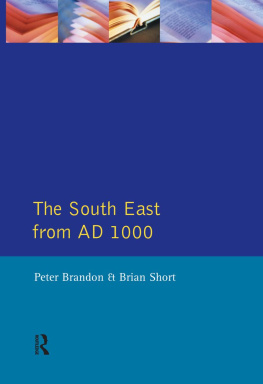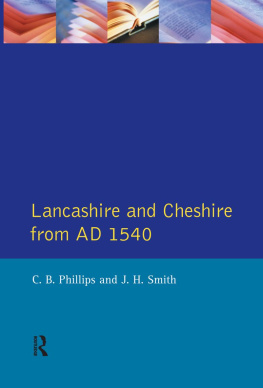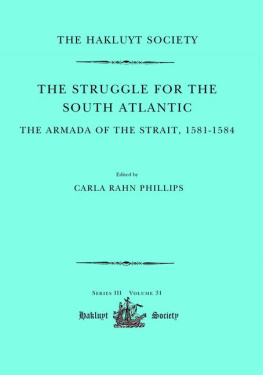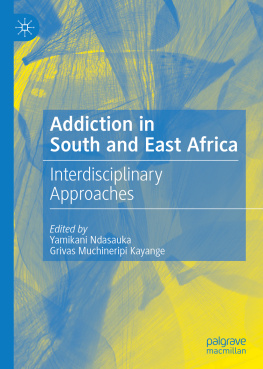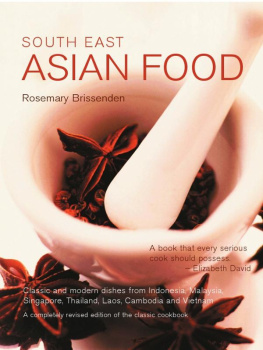The South East from AD 1000
Regional History of England
General Editors: Barry Cunliffe and David Hey
For full details of the series, see pp.
The South East from AD 1000
Peter Brandon and Brian Short
First Published 1990 by Longman Group UK Limited
Published by the United States of America
by Longman Inc.
Published 2014 by Routledge
2 Park Square, Milton Park, Abingdon, Oxon OX14 4RN
711 Third Avenue, New York, NY 10017 USA
Routledge is an imprint of the Taylor & Francis Group, an informabusiness
Taylor & Francis 1990
All rights reserved; no part of this publication may be reproduced, stored in a retrieval system, or transmitted in any form or by any means, electronic, mechanical, photocopying, recording, or otherwise, without either the prior written permission of the Publishers or a licence permitting restricted copying issued by the Copyright Licensing Agency Ltd., 33-34 Alfred Place, London WC1E 7DP.
British Library Cataloguing in Publication Data
Brandon Peter F.
The South East from AD 1000. (Regional history of England),
1. South East England, history
I. Title II. Short, Brian, 1944 -III. Series 942.2
ISBN 0-582-49246-7 CSD
ISBN 978-0-582-49245-5 PPR
ISBN 978-1-315-83671-3 (eISBN)
Library of Congress Cataloging-in-Publication Data
Brandon, Peter F., 1927-
The South East from AD 1000/Peter F. Brandon and Brian M. Short.
p. cm. (Regional history of England)
Bibliography: p.
Includes index.
ISBN 0-582-49246-7 ISBN 0-582-49245-9 (pbk.) 1. Kent (England)
History. 2. Surrey (England) History. 3. East Sussex (England) History. 4. West Sussex (England) History. 5. London (England) History. 6. England History, Local. I. Short, Brian M., 1944 II. Title. III. Title: South East from AD one thousand. IV. Series.
DA670.K3B73 1988
942dc20
89-34441
CIP
Transferred to digital print on demand 2001
Contents
Chapter 1
The Personality of South-East England |
Chapter 2
The Early Middle Ages |
Chapter 3
The Later Middle Ages |
Chapter 4
The South East in Transition, 15201660 |
Chapter 5
Innovation and Stress, 16601837 |
Chapter 6
A Century of Change, 18371939 |
Chapter 7
'Megalopolis Denied': The South East since 1939 |
The authors and publishers would like to thank the following for their permission to use the illustrations in the text:
Archaeologia Cantiana (); Brighton Marina Company (7.3); The Trustees of the British Museum (2.3, 2.5, 5.2, 6.1); British Library (5.9); British Rail Pension Fund Works of Art Collection (5.5); the British Transport Museum (6.11); Chichester Cathedral Publications (2.8); Country Life (6.10); East Sussex County Council (E.1); English Heritage (3.4); Government Art Collection (4.5); Hastings Museum & Art Gallery (5.10); George Holleyman (6.2); Howard Grey from Omega and After: Bloomsbury and the Decorative Arts (Thames and Hudson) (6.8); London Transport Museum (6.5); Meridian Airmaps, Lancing (1.1); The National Maritime Museum, Greenwich (2.6, 2.7); National Library of Vienna (5.4); Painshill Park Trust (5.6); Parham Park Ltd (4.1); Edward Reeves (1.2, 3.1, 4.3); The Royal Blackheath Golf Club (6.6); Science & Engineering Research Council (3.3); Spink & Son Ltd (5.1); Surrey Archaeological Society (4.1); Sussex Rural Community Council (1.3); Times Newspapers (7.1); Tony Stone Worldwide Photolibrary (6.4); Victoria County History (4.6); Tapisserie de Bayeux (2.1); Weald & Downland Museum (3.2).
England cannot be divided satisfactorily into recognizable regions based on former kingdoms or principalities in the manner of France, Germany or Italy. Few of the Anglo-Saxon tribal divisions had much meaning in later times and from the eleventh century onwards England was a united country. English regional identities are imprecise and no firm boundaries can be drawn. In planning this series we have recognized that any attempt to define a region must be somewhat arbitrary, particularly in the Midlands, and that boundaries must be flexible. Even the South-West, which is surrounded on three sides by the sea, has no agreed border on the remaining side and in many ways, historically and culturally, the River Tamar divides the area into two. Likewise, the Pennines present a formidable barrier between the eastern and western counties on the Northern Borders; contrasts as much as similarities need to be emphasized here.
The concept of a region does not imply that the inhabitants had a similar experience of life, nor that they were all inward-looking. A Hull merchant might have more in common with his Dutch trading partner than with his fellow Yorkshireman who farmed a Pennine smallholding: a Roman soldier stationed for years on Hadrian's Wall probably had very different ethnic origins from a native farmer living on the Durham boulder clay. To differing degrees, everyone moved in an international climate of belief and opinion with common working practices and standards of living.
Yet regional differences were nonetheless real; even today a Yorkshireman may be readily distinguished from someone from the South East. Life in Lancashire and Cheshire has always been different from life in the Thames Valley. Even the East Midlands has a character that is subtly different from that of the West Midlands. People still feel that they belong to a particular region within England as a whole.
In writing these histories we have become aware how much regional identities may vary over time; moreover how a farming region, say, may not coincide with a region defined by its building styles or its dialect. We have dwelt upon the diversity that can be found within a region as well as upon common characteristics in order to illustrate the local peculiarities of provincial life. Yet despite all of these problems of definition, we feel that the time is ripe to attempt an ambitious scheme outlining the history of England's regions in twenty-one volumes. London has not been included - except for demonstrating the many ways in which it has influenced the provinces for its history has been very different from that of the towns and rural parishes that are our principal concern.
In recent years an enormous amount of local research, both historical and archaeological, has deepened our understanding of the former concerns of ordinary men and women and has altered our perception of everyday life in the past in many significant ways, yet the results of this work are not widely known even within the regions themselves.
This series offers a synthesis of this new work from authors who have themselves been actively involved in local research and who are present in or former residents of the regions they describe.
Each region will be covered in two linked but independent volumes, the first covering the period up to AD 1000 and necessarily relying heavily on archaeological data, and the second bringing the story up to the present day. Only by taking a wide time-span and by studying continuity and change over many centuries do distinctive regional characteristics become clear.
This series portrays life as it was experienced by the great majority of the people of South Britain or England as it was to become. The twenty-one volumes will it is hoped substantially enrich our understanding of English history.


